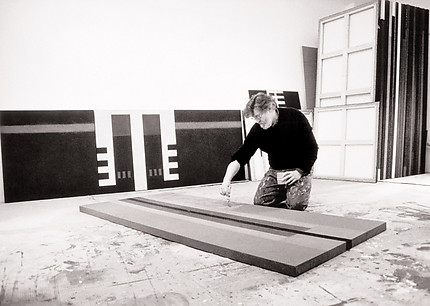 The studio. Paris, 1995 (photograph by Patrick Ullmann) |
Note Biographique
José Giger was born in Geneva on January 5th 1938. An only child, he has Swiss-German origins through his father (St. Gallen), and latin roots through his mother, whose father was from the Aosta Valley and whose mother was Savoyard.
His interest in graphic expression urged him to graduate from the Ecole des Arts Décoratifs in Geneva in 1958 and then to attend the Beaux Arts in the same town. This path led him naturally to painting, to which he would henceforth devote his life.
While conveying light in representation was Giger’s main approach as a painter, it was the representation of emotion through matter and light which brought him to abstract art as early as 1965.
His sense of place led him to create his own living and work spaces. Likewise, his passion for faraway regions was a factor in his work’s evolution.
He often stayed in Provence and Paris in the early sixties, in Greece in the seventies and eighties. His experience of Polynesia in 1988 had a powerful impact on him. For the last fifteen years, he has been dividing his time between his studios in Paris and in Geneva.
Although his works figure in several public and private collections, José Giger is more concerned with his research than with the exhibiting of it. His career has however been punctuated with a few personal and collective exhibitions.
He first exhibited in 1997 his Giants , the synthesis of his nonrepresentational work. His recent research is an extension of these.
The Giants, at first monumental paintings, now find a three-dimensional expression in the form of painted works several meters high.
In the classic viewer-painting relationship, José Giger offered the spectator an encounter, by pushing him beyond simple confrontation to enter into a state of fusion.
Through his recent installations, which combine paintings and three-dimensional works, he encourages the viewer to enter a triangular relationship. First spectator of the dialogue between the two-dimensional painting and its three-dimensional counterpart, the viewer then becomes an actor and integrant part of a new dimension created at this very instant.



